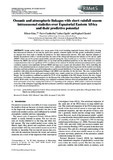| dc.contributor.author | Gitau, Wilson | |
| dc.contributor.author | Camberlin, Pierre | |
| dc.contributor.author | Ogallo, Laban | |
| dc.contributor.author | Okoola, Raphael | |
| dc.date.accessioned | 2015-01-05T13:36:31Z | |
| dc.date.available | 2015-01-05T13:36:31Z | |
| dc.date.issued | 2014 | |
| dc.identifier.citation | Gitau, W., Camberlin, P., Ogallo, L., & Okoola, R. (2014). Oceanic and atmospheric linkages with short rainfall season intraseasonal statistics over Equatorial Eastern Africa and their predictive potential. International Journal of Climatology. | en_US |
| dc.identifier.uri | http://www.icpac.net/products/research/Oceanic%20and%20Atmospheric%20linkages%20with%20short%20rainfall%20season%20intreaseasonal%20statistics%20over%20EEA%20and%20their%20predictive%20potential_IJoC.pdf | |
| dc.identifier.uri | http://hdl.handle.net/11295/79018 | |
| dc.description.abstract | Despite earlier studies over various parts of the world including equatorial Eastern Africa (EEA) showing
that intraseasonal statistics of wet and dry spells have spatially coherent signals and thus greater predictability potential,
no attempts have been made to identify the predictors for these intraseasonal statistics. This study therefore attempts to
identify the predictors (with a 1-month lead time) for some of the subregional intraseasonal statistics of wet and dry spells
(SRISS) which showed the greatest predictability potential during the short rainfall season over EEA. Correlation analysis
between the SRISS and seasonal rainfall totals on one hand and the predefined predictors on the other hand were initially
computed and those that were significant at 95% confidence levels retained. To identify additional potential predictors, partial
correlation analyses were undertaken between SRISS and large-scale oceanic and atmospheric fields while controlling the
effects of the predefined predictors retained earlier. Cross-validated multivariate linear regression (MLR) models were finally
developed and their residuals assessed for independence and for normal distribution. Four large-scale oceanic and atmospheric
predictors with robust physical/dynamical linkages with SRISS were identified for the first time. The cross-validated MLR
models for the SRISS of wet spells and seasonal rainfall totals mainly picked two of these predictors around the Bay of
Bengal. The two predictors combined accounted for 39.5% of the magnitude of the SST changes between the July–August
and October–November–December periods over the Western Pole of the Indian Ocean Dipole, subsequently impacting EEA
rainfall. MLR models were defined yielding cross-validated correlations between observed and predicted values of seasonal
totals and number of wet days ranging from 0.60 to 0.75, depending on the subregion. MLR models could not be developed
over a few of the subregions suggesting that the local factors could have masked the global and regional signals encompassed
in the additional potential predictors | en_US |
| dc.language.iso | en | en_US |
| dc.publisher | University of Nairobi | en_US |
| dc.subject | predictability; equatorial Eastern Africa; intraseasonal statistics; wet and dry spells; Bay of Bengal; Indian Ocean Dipole; sea surface temperature | en_US |
| dc.title | Oceanic and atmospheric linkages with short rainfall season intraseasonal statistics over Equatorial Eastern Africa and their predictive potential | en_US |
| dc.type | Article | en_US |
| dc.type.material | en_US | en_US |

